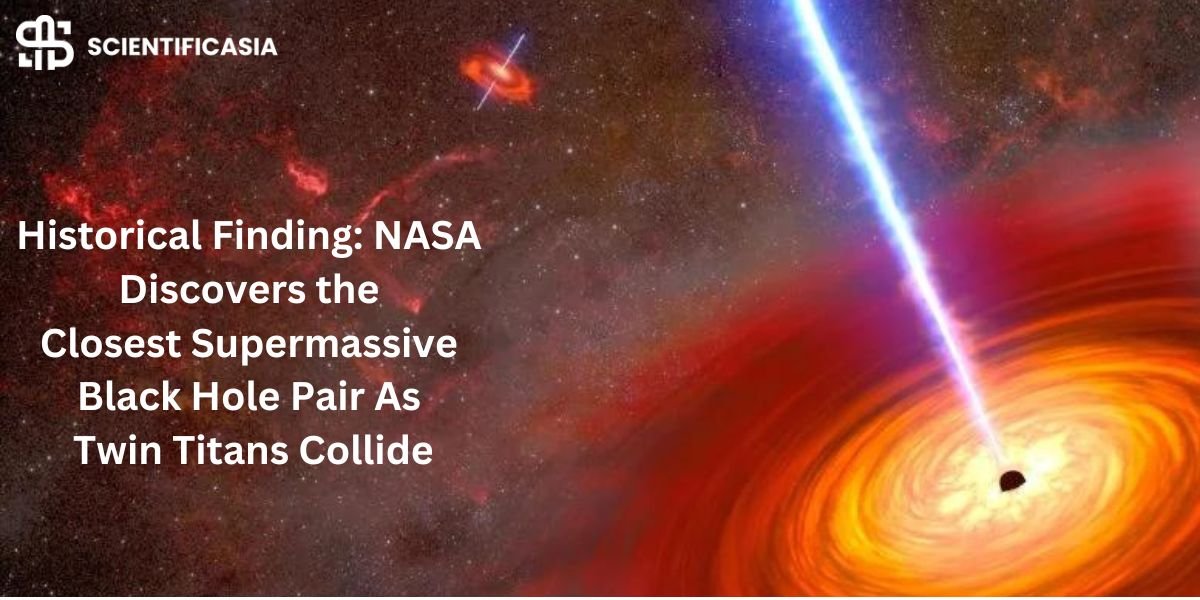Two Galaxies’ Cores Are Heading Toward Collision
Stars flying through space essentially never collide with one another. A star-like sun’s diameter and its distance from the next star in proximity are roughly 1:10 million. However, galaxies do collide. The distance of 2.2 million light-years separates our galaxy from the nearby Andromeda galaxy. That is merely a 1:20 ratio. Furthermore, the two titans will eventually collide and fuse.
Black holes from colliding galaxies combine to form one enormous black hole. At the heart of almost every galaxy is a supermassive black hole.
When the Chandra X-ray Observatory and the Hubble Space Telescope peered deep into a pair of colliding galaxies, they discovered twin supermassive black holes waltzing around one another. Engorged with falling gas, the black hole pair shines as active galactic nuclei (AGN). They are the closest AGN pair observed in visible light and X-ray wavelengths, separated by about 300 light-years.
The nearest verified duo of supermassive black holes have been seen closely together. These were discovered with the help of NASA’s Chandra X-ray Observatory and Hubble Space Telescope, and they are situated about 300 light-years apart. Nestled deep within two colliding galaxies, these black holes glow brilliantly as active galactic nuclei (AGN) due to infalling gas and dust. Goddard Space Flight Center, a division of NASA
NASA’s Chandra and Hubble Discover a Supermassive Black Hole Pair
Similar to two Sumo wrestlers facing off, the nearest confirmed pair of supermassive black holes have been seen to be quite close together. NASA’s Hubble Space Telescope and the Chandra X-ray Observatory were used to detect these, which are roughly 300 light-years away. These black holes, located deep within two colliding galaxies, glow brightly as active galactic nuclei (AGN) due to infalling gas and dust.
Using multiwavelength (visible and X-ray light) investigations, this AGN pair is the closest one found in the local universe. While several “dual” black holes had previously been detected, they usually have far larger separations than the ones observed in the gas-rich galaxy MCG-03-34-64. Radio telescope observations have shown one binary black hole pair to be significantly closer than in MCG-03-34-64, although there has been no confirmation at other wavelengths.
This type of AGN double was probably more common in the early cosmos when galaxy mergers were more widespread. This find offers a rare up-close view of a neighboring example that is roughly 800 million light-years away.
The merger of two galaxies that will someday collide produced the black hole pair. NASA, ESA, Joseph DePasquale (STScI), Anna Trindade Falcão (CfA).
Coincident Discoveries from Hubble and Chandra
The finding was coincidental. Three optical diffraction spikes nested inside the host galaxy were discovered by Hubble’s high-resolution imagery. These spikes indicated a significant concentration of blazing oxygen gas in a relatively limited location. Lead author Anna Trindade Falcão of the Center for Astrophysics | Harvard & Smithsonian in Cambridge, Massachusetts, stated, “We were not expecting to see something like this.” The article was published in The Astrophysical Journal today, September 9. “This view indicated that there is activity within the galaxy, as it is uncommon in the nearby universe.”
When light from a relatively small area in space bends around the mirror within telescopes, image abnormalities known as diffraction spikes are produced.
Falcão’s group then used the Chandra observatory to study the same galaxy in X-ray radiation to delve deeper into the details. “We observed two distinct, strong sources of high-energy emission simultaneous with the brilliant optical points of light observed with Hubble when we examined MCG-03-34-64 in the X-ray band. After assembling all of the parts, we were probably staring at two supermassive black holes that were quite near to one another, Falcão stated.
Analyzing Signals at Different Wavelengths
The scientists employed historical radio data from the Karl G. Jansky Very Large Array close to Socorro, New Mexico, to bolster their interpretation. Additionally, the dynamic pair of black holes produces intense radio waves. After ruling out several possibilities, it is determined that intense light observed at optical, X-ray, and radio wavelengths can only be explained by nearby black holes.
The picture of the AGN duo is what you get when you put all the pieces together, according to Falcão.
Hubble has observed a third strong light source, but its origin is uncertain and requires further investigation.
That gas may be the equivalent of a garden hose shooting into a sand pile—gas stunned by the energy of an ultra-high-speed plasma jet shot from one of the black holes.
Without Hubble’s incredible clarity, we couldn’t see all of these details, according to Falcão.
Consequences for the Future and Current Research
In the past, the centers of each of the two supermassive black holes‘ host galaxies were located there. The black holes were drawn close by a merger between the galaxies. In over 100 million years, they will finally merge, rattling space and time as gravitational waves as they spiral closer and closer together.
Gravitational waves have been observed in dozens of mergers between stellar-mass black holes by the Laser Interferometer Gravitational-Wave Observatory (LIGO) of the National Science Foundation. Nevertheless, LIGO is unable to detect the longer wavelengths that arise from a supermassive black hole merger.
To detect these longer wavelength gravitational waves from deep space, the next generation gravitational wave detector, known as the LISA (Laser Interferometer Space Antenna) mission, will be composed of three detectors in orbit, separated by millions of kilometers. This mission, which is being led by the European Space Agency (ESA) in collaboration with NASA and other cooperating organizations, is scheduled to launch in the middle of the 1930s.
Reference: “Resolving a Candidate Dual Active Galactic Nucleus with ∼100 pc Separation in MCG-03-34-64” by Anna Trindade Falcão, T. J. Turner, S. B. Kraemer, J. Reeves, V. Braito, H. R. Schmitt and L. Feuillet, 9 September 2024, The Astrophysical Journal.
DOI: 10.3847/1538-4357/ad6b91
A key space science project, the Chandra X-ray Observatory is overseen by NASA’s Marshall Space Flight Center and focuses on X-ray astronomy. The Chandra X-ray Center of the Smithsonian Astrophysical Observatory, with locations in Cambridge and Burlington, Massachusetts, respectively, is in charge of the scientific operations and flight controls. Northrop Grumman Space Technologies, the prime contractor, led the spacecraft’s construction from Redondo Beach, California.
The Hubble Space Telescope has advanced astronomical research and expanded our knowledge of the universe for more than thirty years. NASA and the European Space Agency (ESA) worked together on this enormous project.
NASA’s Goddard Space Flight Center is in charge of the telescope and its mission operations, while the Space Telescope Science Institute is in charge of the science operations. The Association of Universities for Research in Astronomy, which runs this Institute in Baltimore, Maryland, collaborates closely with Lockheed Martin Space, located in Denver, Colorado, to support these mission activities.
Recommended Articles
















